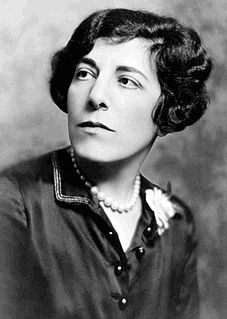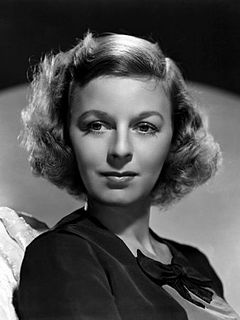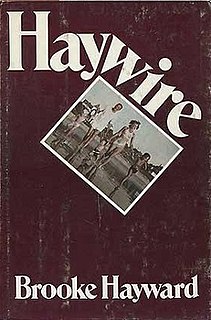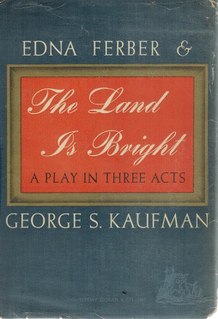Related Research Articles

Eve Arden was an American film, radio, stage and television actress. She performed in leading and supporting roles for nearly six decades.

George Simon Kaufman was an American playwright, theater director and producer, humorist, and drama critic. In addition to comedies and political satire, he wrote several musicals for the Marx Brothers and others. He won the Pulitzer Prize for Drama for the musical Of Thee I Sing in 1932, and won again in 1937 for the play You Can't Take It with You. He also won the Tony Award for Best Director in 1951 for the musical Guys and Dolls.

Edna Ferber was an American novelist, short story writer and playwright. Her novels include the Pulitzer Prize-winning So Big (1924), Show Boat, Cimarron, Giant and Ice Palace (1958), which also received a film adaptation in 1960.

Moss Hart was an American playwright, librettist, and theatre director.

Stage Door is a 1937 RKO film directed by Gregory La Cava. Adapted from the play of the same name, it tells the story of several would-be actresses who live together in a boarding house at 158 West 58th Street in New York City. The film stars Katharine Hepburn, Ginger Rogers, Adolphe Menjou, Gail Patrick, Constance Collier, Andrea Leeds, Samuel S. Hinds and Lucille Ball. Eve Arden and Ann Miller, who became notable in later films, play minor characters.

Margaret Brooke Sullavan was an American stage and film actress.

Joseph Leo Mankiewicz was an American film director, screenwriter, and producer. Mankiewicz had a long Hollywood career, and won both the Academy Award for Best Director and the Academy Award for Best Adapted Screenplay in consecutive years for A Letter to Three Wives (1949) and All About Eve (1950), the latter of which was nominated for 14 Academy Awards and won six.

Gay Divorce is a musical with music and lyrics by Cole Porter and book by Dwight Taylor, adapted by Kenneth Webb and Samuel Hoffenstein. It was Fred Astaire's last Broadway show and featured the hit song "Night and Day" in which Astaire danced with co-star Claire Luce.

Leland Hayward was a Hollywood and Broadway agent and theatrical producer. He produced the original Broadway stage productions of Rodgers and Hammerstein's South Pacific and The Sound of Music.

The Royal Family is a play written by George S. Kaufman and Edna Ferber. Its premiere on Broadway was at the Selwyn Theatre on 28 December 1927, where it ran for 345 performances to close in October 1928. It was included in Burns Mantle's The Best Plays of 1927–1928.

Roland Young was an English-born actor. He began his acting career on the London stage, but later found success in America and received an Academy Award nomination for his role in the film Topper (1937).

Barbara O'Neil was an American film and stage actress. She appeared in the film Gone with the Wind (1939) and was nominated for the Academy Award for Best Supporting Actress for her performance in All This, and Heaven Too (1940).

Constance Collier was an English stage and film actress and acting coach. She wrote hit plays and films with Ivor Novello and she was the first person to be treated with insulin in Europe.

Jed Harris was an Austrian-born American theatrical producer and director. His many successful Broadway productions in the 1920s and 1930s include Broadway (1926), Coquette (1927), The Royal Family (1927), The Front Page (1928), Uncle Vanya (1930), The Green Bay Tree (1933) and Our Town (1938). He later directed the original Broadway productions of The Heiress (1947) and The Crucible (1953).

Show Boat is a 1926 novel by American author and dramatist Edna Ferber. It chronicles the lives of three generations of performers on the Cotton Blossom, a floating theater on a steamboat that travels between small towns along the banks of the Mississippi River, from the 1880s to the 1920s. The story moves from the Reconstruction Era riverboat to Gilded Age Chicago to Roaring Twenties New York, and finally returns to the Mississippi River.
Muriel King (1900–1977) was an American fashion designer based in New York City. She was one of the first American fashion designers along with Elizabeth Hawes and Clare Potter to achieve name recognition. She also designed costumes for several major films in the 1930s and 1940s.

Haywire is a 1977 memoir by actress and writer Brooke Hayward, daughter of theatrical agent and producer Leland Hayward and actress Margaret Sullavan. It is a #1 New York Times Best Seller and was on the newspaper's list for 17 weeks. In Haywire, Brooke details her experience of growing up immersed in the glamorous and extravagant lifestyle afforded by her parents’ successful Hollywood and Broadway careers and tells the story of how her privileged, beautiful family and their seemingly idyllic life fell apart.
Anthony Veiller was an American screenwriter and film producer. He wrote for 41 films between 1934 and 1964.
The Rehearsal Club was a theatrical girls' boarding house was founded in 1913 by Jean "Daisy" Greer, daughter of New York's Episcopal bishop, and Episcopal Deaconess Jane Harriss Hall. The residence provided young women pursuing a life in the theater a place to rest between auditions, along with opportunities to socialize and receive simple meals. Within a year, the Professional Children’s School was established in back parlors of The Rehearsal Club.

The Land Is Bright is a 1941 dramatic play by George S. Kaufman and Edna Ferber.
References
- 1 2 3 "Origins of 'Stage Door,'" The New York Times October 25, 1936.
- 1 2 Meredith, Scott. George S. Kaufman and His Friends. Garden City: Doubleday & Company, 1974. 502-4.
- ↑ Rinella, Michael D. Margaret Sullavan: The Life and Career of a Reluctant Star. Jefferson: McFarland & Company, 2019. 95.
- ↑ Quirk, Lawrence J. Margaret Sullavan: Child of Fate. New York: St. Martin's Press, 1986. 74.
- ↑ Gilbert, Julie Goldsmith. Ferber. Garden City: Doubleday & Company, 1978. 323.
- 1 2 "Movie of the Week: 'Stage Door': Four Movie Queens and a Baby made it a newsy play," Life September 27, 1937.
- ↑ Smith, Cecil. "Lively Revival of 'Stage Door' Opens Its Run," Chicago Daily Tribune April 5, 1943.
- ↑ "RKO-Radio Acquires Kaufman-Ferber Opus, 'Stage Door,'" The New York Times November 28, 1936.
- ↑ Crosby, John. "They've Drawn the Sting From 'Stage Door,'" The Washington Post March 12, 1950.
- ↑ Shanley, J. P. "Television: 'Stage Door,'" The New York Times April 8, 1955.
- ↑ Corry, John. "A Musical 'Stage Door' To Open in the Autumn," The New York Times February 11, 1981.
